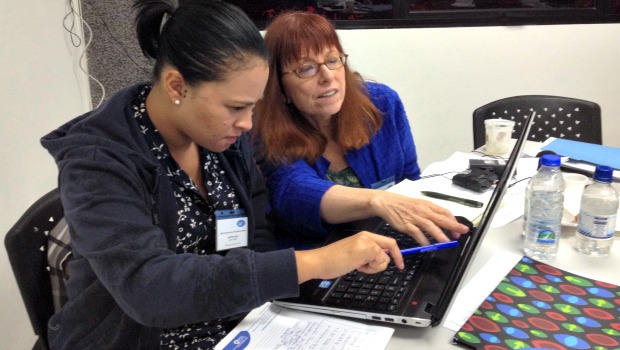ICIJ has hundreds of members across the world. Typically, these journalists are the best in the country and have won many national and global awards.
Our monthly series, Meet the Investigators, highlights the work of these tireless journalists. This month, we speak with award-winning American reporter Margot Williams, research editor for investigations at The Intercept. Previous to her current position Williams worked at the Washington Post, National Public Radio, The New York Times, and, even at ICIJ. At the Washington Post, Williams was a member of two Pulitzer Prize-winning teams for an investigation into police shootings and for national coverage of terrorism.
While at the New York Times, you took notes on 16,000 pages of court documents regarding the detainees held in the shadows at Guantanamo Bay, Cuba. This became the first comprehensive look at who the United States was holding at the island detention facility during the George W. Bush administration. How did you become interested in making this list?
As soon as the first orange-suited men arrived at Guantanamo Bay detention camp in January 2002, I became obsessed by the secrecy and anonymity of the military operation. Who were these people, and how did they get there? How did their capture and detention relate to the still-raw tragedy of the attacks on the World Trade Center and the Pentagon? What were their names? I was determined to uncover these facts as much as I could from behind a computer screen in Washington, D.C.
Can you talk at all about what research methods you used and how you figured out how to piece it all together?
Remember that a list of names did not become public until April 2006 in response to a Freedom of Information Act lawsuit by the Associated Press.
Before that I had been compiling my own list, using news accounts and information from lawyers and the web, like an Arabic language web site called Alasra.org and the official publication of the Yemeni Defense Ministry, also in Arabic. I did not read Arabic so it was a struggle. This list was published in The Washington Post with the project reported by Scott Higham and Joe Stephens in May 2004, and I was the third name on the byline. Pride!
I read for details and clues more than the general meaning. I obsessively analyze the footnotes.
In 2006, when the documents, the records of the Combatant Status Review Tribunals held in Guantanamo, were made available via the AP’s FOIA lawsuit, I had moved to the New York Times as the research database editor on the computer assisted reporting (now we’d call it “data journalism”) team.
My colleagues there figured out how to use “new” optical character recognition tools to make the pages searchable, and we created a database. But first I had to read them and connect each document to an individual detainee on the public list. No, the documents did not have the detainee names on them. So I entered the information found by reading all those documents into a spreadsheet, and it became data!
At first reporters used the information for background on Guantanamo stories. Soon my colleagues Aron Pilhofer, Tom Torok, Andrei Scheinkman, Jacob Harris and Archie Tse created an interactive, first published online in November 2008, that is still alive and updated regularly by Jeremy Bowers.

Did this enormous effort require a degree of personal obsession?
True. I know all their names and still am trying to learn their stories. I finally was able to go to Guantanamo myself for The Intercept, twice in 2017, to attend the pre-trial hearings of the five men charged with the 9/11 attacks. It looks like I am going back in June, if approved, to get on the official media tour of the base.
In 2009, you told ProPublica: “I am a reader of documents. There’s no substitute for reading every line of every page.” For all our skills in acquiring documents, could reporters stand to improve how closely we read the documents we obtain?
I have to confess that I read for details and clues more than the general meaning. I obsessively analyze the footnotes. On a big document, I start at the end and read backwards because I know everyone else is starting from the beginning and often stops before the end. I try to find within a document what can be counted, aggregated, analyzed.
Your title is research editor, right? I’ve also seen you referred to as a librarian of various types. Is there a difference between reporting and research/library work?
My career started at Time Inc.’s research library after graduation from Pratt Institute with a Master’s in Library and Information Science. I’ve been a Research Librarian, News Research Analyst, Library Director, News Researcher, Research Editor, Research Database Editor and Investigative Research Editor. I’ve also reported, fact-checked and done data analysis. My work (and the work of most news researchers, I believe) is centered on documents and data, rather than sources, interviews and writing. We work in partnerships with reporters and as members of project teams, with editors, reporters, graphics designers and developers. We’re collaborators. We’re all journalists.
What can reporters learn from researchers and librarians? How can we incorporate a researcher/librarian approach into our own work?
The skill of the researcher/librarian is finding the best, most reliable sources of information. We’re trained and steeped in fact-finding and verification. In an expanding universe of facts and falsehoods, new tools and traditional skills are essential.
You’ve created this great list of databases in a shared Google Doc, can you name a couple of favorites?
I have been keeping that list of databases current for twenty years. A new version will be available at the Investigative Reporters and Editors (IRE) conference in June. Of course, my favorite database at the moment relates to whatever the project or beat I’m researching, so right now its Marine Traffic (www.marinetraffic.com) for tracking ships and FlightRadar24 (www.flightradar24.com) for unblocked planes. I’m recommending Enigma (www.enigma.io) for its free and accessible repository of public data. I subscribe and pay for databases that are superior to free ones. Often reporters ask me how to get stuff for free when, indeed, it has to be paid for. Nexis, Accurint, TLO, Ancestry, Arachnys are worth paying for, in my opinion.
As newsroom budgets shrink, more and more investigative journalism is done on a freelance basis. A lot of reporters are starting their careers as freelancers without professional mentors or formal on-the-job training. How can freelancers both learn and stay up to speed on investigative reporting methods?
My best answer to that is to be a member of IRE and attend its workshops and conferences and use the tools and tip sheets on the web site. The GIJN (Global Investigative Journalism Network) conferences and its web site are awesome, too. Join your country’s investigative reporting organization, join the listserv, be grateful for your colleagues’ generosity and share your knowledge, too.

